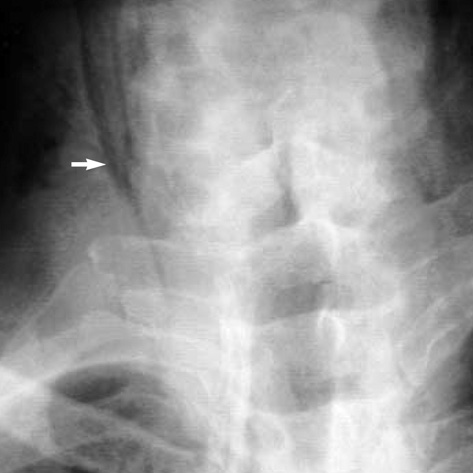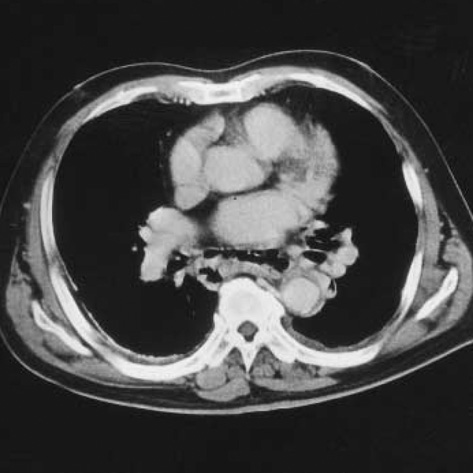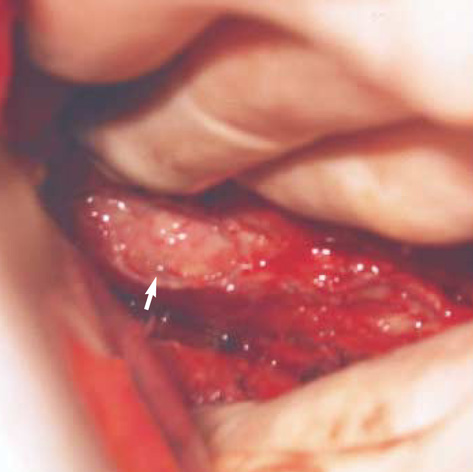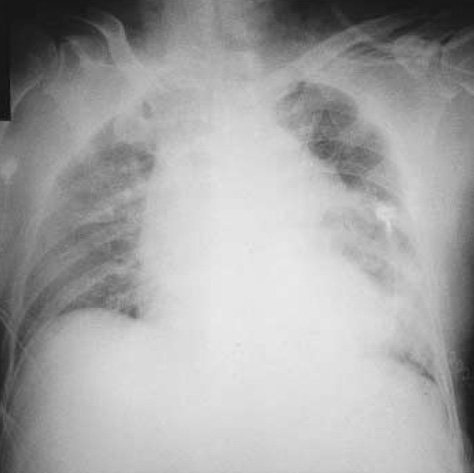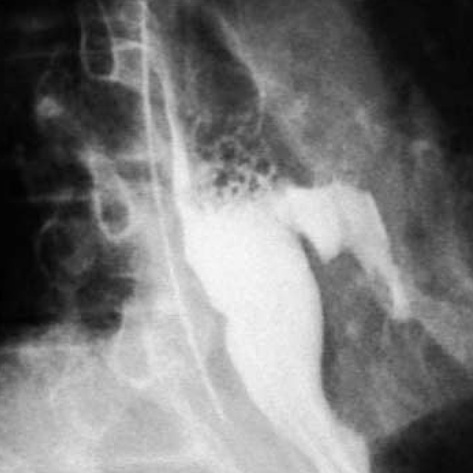J Korean Med Sci.
2004 Dec;19(6):887-890. 10.3346/jkms.2004.19.6.887.
Delayed Primary Repair of Perforated Epiphrenic Diverticulum
- Affiliations
-
- 1Department of Cardiothoracic Surgery, The Catholic University of Korea, College of Medicine, Seoul, Korea. kyh7890@catholic.ac.kr
- 2Department of Internal Medicine, The Catholic University of Korea, College of Medicine, Seoul, Korea.
- KMID: 1778574
- DOI: http://doi.org/10.3346/jkms.2004.19.6.887
Abstract
- A 68-yr-old man complaining of sudden, postprandial chest pain visited the emergency room. His symptom had been aggravated during the preceding two days. Upper gastrointestinal contrast study with gastrographin showed leakage of dye from the epiphrenic diverticulum in the lower third of the esophagus. The primary repair was urgently carried out. Upper gastrointestinal contrast study 14 days after operation revealed an esophageal leakage which was small and confined. The patient was managed with conservative treatments such as intravenous hyperali-mentation and broad-spectrum antibiotics. Forty-two days after the operation, a gastrographin swallow study showed the absence of leaks. This is the first report-ed case of a perforated epiphrenic esophageal diverticulum repaired by delayed primary repair in Korea.
MeSH Terms
Figure
Reference
-
1. Bruggeman LL, Seaman WG. Epiphrenic diverticula: an analysis of 80 cases. Am J Roentgenol Radium Ther Nucl Med. 1973. 119:266–276.2. Debas HT, Payne WS, Cameron AJ, Carlson HC. Physiopathology of lower esophageal diverticulum and its implications for treatment. Surg Gynecol Obstet. 1980. 151:593–600.3. Benacci JC, Deschamps C, Trastek VF, Allen MS, Daly RC, Pairolero PC. Epiphrenic diverticulum: results of surgical treatment. Ann Thorac Surg. 1993. 55:1109–1114.
Article4. Abul-Khair MH, Khalil A, Mohsen A. Bleeding from an epiphrenic esophageal diverticulum. Eur J Surg. 1992. 158:377–378.5. Hoxie DA, Dilon MC, Tuckson WB, DeSai RM. Profuse bleeding in epiphrenic diverticula: an unusual finding. J Natl Med Assoc. 1995. 87:373–375.6. Jordan PH Jr, Kinner BM. New look at epiphrenic diverticula. World J Surg. 1999. 23:147–152.7. Borri J, Wilson RL. Esophageal diverticula: principles of management and appraisal of classification. Thorax. 1980. 35:759–767.8. Fasano NC, Levine MS, Rubesin SE, Redfern RO, Laufer I. Epiphrenic diverticulum: Clinical and radiographic findings in 27 patients. Dysphagia. 2003. 18:9–15.
Article9. Lee YC, Lee ST, Chu SH. New technique of esophageal exclusion for chronic esophageal perforation. Ann Thorac Surg. 1991. 51:1020–1022.
Article10. Bardini R, Bonavina L, Pavarello M, Asolati M, Peracchia A. Temporary double exclusion of the perforated esophagus using absorbable staples. Ann Thorac Surg. 1992. 54:1165–1167.
Article11. Grillo HC, Wilkins EW Jr. Esophageal repair following late diagnosis of intrathoracic perforation. Ann Thorac Surg. 1975. 20:387–399.
Article12. Kim KD, Chung KY, Kim CS, Park HK. Delayed primary repair of esophageal rupture. Korean J Thorac Cardiovasc Surg. 1998. 31:6–51.13. Wang N, Razzouk AJ, Safavi A, Gan K, Van Arsdell GS, Burton PM, Fandrich BL, Wood MJ, Hill AC, Vyhmeister EE, Miranda R, Ahn C, Gundry SR. Delayed primary repair of intrathoracic esophageal perforation: is it safe? J Thorac Cardiovasc Surg. 1996. 111:114–122.
Article14. Orringer MB, Stirling MC. Esophagectomy for esophageal disruption. Ann Thorac Surg. 1990. 49:35–43.
Article15. Richardson JD, Martin LF, Borzotta AP, Polk HC Jr. Unifying concepts in the treatment of esophageal leaks. Am J Surg. 1985. 149:157–162.16. Jara FM. Diaphragmatic pedicle flap for treatment of Boerhaave's syndrome. J Thorac Cardiovasc Surg. 1979. 78:931–933.
Article
- Full Text Links
- Actions
-
Cited
- CITED
-
- Close
- Share
- Similar articles
-
- A Case of Dysphagia with Epiphrenic Diverticulum
- Three Cases of Epiphrenic Diverticula Associated With Esophageal Motility Disorders
- A Case of Esophageal Achalasia with Epiphrenic Diverticulum
- A Large Epiphrenic Esophageal Diverticulum Communicating with the Left Lower Lobe
- Usefulness of EndoFLIP in Diverticular Peroral Endoscopic Myotomy for Symptomatic Epiphrenic Diverticulum

